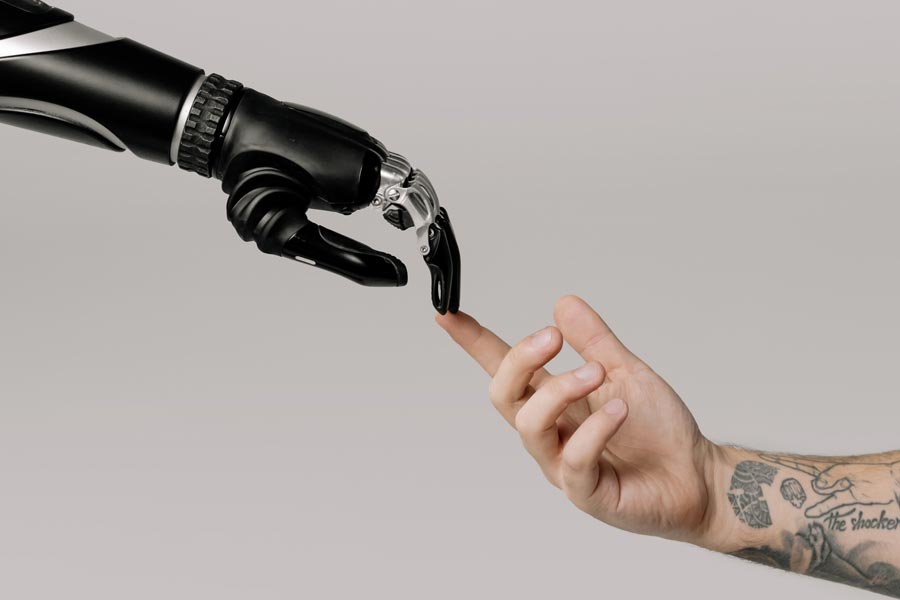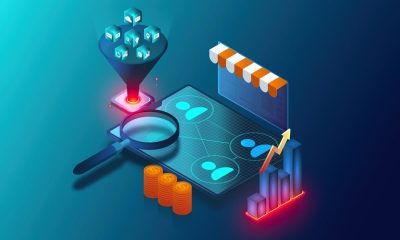General Advice
Getting Started with AI: Practical Tools for SMEs

Startups. A buzzword that we frequently hear. And one which falls short in describing the cut-throat nature of business in the 21st Century. With an eye toward fixing present and upcoming problems, some extraordinary people tend to rise above others and create new enterprises and organisations. Startups; Small and Medium-sized Enterprises (SMEs), are built upon these concepts. Although SMEs are the backbone of the global economy, they tend to struggle when it comes to competing with larger companies. They (you) need all the help they can get, building efficiency into the foundations of the business right from the start. AI isn’t a new concept, but the amount of software being developed utilising it to help improve the quality and efficiency of data manipulation and task management has exploded over the past year. But with all the offerings out there, and so many new ideas coming to market, what exactly can your business actually use right now that will help? Well, to give you some guidance, here are some tools you can use as an SME to get a leg up against the big boys.
ChatGPT, a powerful AI-based language model, has gained attention in the commercial world recently. But how can ChatGPT benefit SMEs?
SMEs frequently have limited resources, including financial and human resources, which can make it challenging for them to compete fairly with larger companies. ChatGPT is an exceptional tool for SMEs for “Idea Generation”. If you are a content creator or if you are going to enter the field of content creation, ChatGPT can help you generate ideas for your business. As an SME, if you are a YouTuber, a blogger, or a writer, and you want to create a script or let’s say that you don’t have an idea to start the next chapter of your book, blog, or proposal, you can type your idea in the textbox, and ChatGPT will generate a ton of ideas that you can choose and customise according to your business needs.
Another impressive feature of ChatGPT is its ability to use natural language processing to create personalised and authentic content. By using this feature, SMEs can create outstanding advertisements that cater to their target audience. Let’s say that you want to sell a product or service that targets a specific set of people, ChatGPT can help you create content that will resonate with that audience.
When it comes to the programming industry, ChatGPT has emerged as a true game-changer. SMEs may not have the budget to hire multiple programmers with expertise in different programming languages. With ChatGPT, SMEs can easily convert their code from one language to another in a matter of minutes, without the need to hire a new programmer. SMEs can also use ChatGPT to create a smart chatbot for their website that can answer customer queries about their products or services, providing a personalised experience to the customer.
OpenAI has created another amazing AI tool called DALL-E 2 that can help SMEs with their creative needs. DALL-E 2 can create realistic images and art by using a natural language description. For SMEs, this tool can be a game-changer when it comes to creating visual content.
SMEs can save a ton of time by using DALL-E 2 to create images for their videos or blogs. If you are not familiar with tools like Photoshop, you don’t need to worry about learning anything new. You only need to suggest the idea, and you’ll have a masterpiece in less than a minute.
DALL-E 2 can also be useful for developers who are not good at User Interface design. SMEs can give instructions for their interface, and DALL-E 2 will create great UI designs for their newest website.
For SMEs who are into NFTs or need a good flyer for their next campaign, DALL-E 2 can be their best solution. This AI tool can create the most appropriate and eye-catching post for their latest product, helping SMEs expand their visibility on social media platforms.
In addition, DALL-E 2 can create the best logo for SMEs’ businesses, which can be created using their own thoughts. This can help SMEs establish their brand identity and differentiate themselves from their competitors.
Broadcast is another great AI tool created by NVIDIA. Marketing can be a key factor when it comes to Small and Medium-sized Enterprises (SMEs). The cost of things like microphones, better cameras, editing software, and resourceful people can become a huge burden and stop SMEs from going into something big like this. NVIDIA Broadcast is the best answer to these problems. This tool has several massive features that have amazed many people over the last couple of years.
It includes
- A great noise and echo removal tool that performs incredibly.
- A fantastic background removal tool.
- A feature that can dynamically track your movements in real time.
- An amazing video noise-removal feature.
- An AI tool to make your eyes appear as if they are directly looking at the camera.
Imagine if you are a streamer who is trying to build your image to gain more viewers. Instead of upgrading your hardware, you can have a huge impact on your video by using this simple app. If you are taking a lot of Zoom calls, this can be a game-changer. These tools create the best experience for you and your potential clients as well.
No matter if you are an SME or a large company, you will always need to take online meetings and discussions. This AI tool can help you to be more productive when it comes to online meetings. It can automatically record and transcribe meetings, capturing either video or audio and generating transcripts in minutes. This will help you keep track of meetings in a really good way. Additionally, it can find anything through an AI-powered search.
Not only that, but this tool can also help you collaborate with your co-workers. It can effortlessly share memorable events and notes between certain well-known platforms like “Notion” and “Slack.” It can add comments, pins, and reactions to particular parts, generate sound bites, and write comments.
If you think that’s all, there’s more. It can use conversation intelligence to analyse meetings. You can track speaker talk time, monologues, identify objections, competitors, and other topic trackers, and also measure performance and improve sales.
05. Synthesia
Synthesia is an AI-powered video-generation tool that uses virtual characters resembling real human beings. With Synthesia, you can input text into the tool, and the virtual characters will speak the text as if they were real people. This tool can be really useful in creating advertisements, training videos, how-to videos, and even marketing videos.
Let’s say you have created a website for your product, and you have to make a video on how to use the platform. Or, if you have created a product or a course and you want to make a video on how to use that product, but you have no assets to create such a video as you are a small business. In that context, this tool would come in really handy to save your day.
Synthesia is an exceptional tool that can help Small and Medium-sized Enterprises (SMEs) create high-quality videos without the need for expensive resources or software. By leveraging its powerful features like text-to-speech conversion, SMEs can create engaging and informative videos to promote their products, services, or courses, and improve their brand image in the market.
06. Looka
Looka is an AI-powered logo creation tool that can benefit startups, small businesses, and medium-sized enterprises. When it comes to spreading a business among people as much as possible, the key to success is effective marketing, and a company’s name and logo are crucial in this regard.
Think about Netflix, for example. The red-coloured “N” on a black background immediately comes to mind, demonstrating the power of a perfect logo.
Therefore, having a great logo is key to a business’s success, and Looks can provide just that. Once you enter your brand name, Looka generates a beautiful set of logos for you to choose from. It then quickly generates hundreds of pieces of branded marketing collateral using your logo, colours, and fonts. You can then select a template tailored to your brand and sector and use the Brand Kit’s user-friendly editor to change the look of your brand’s business cards, social media pages, email signatures, and more.
For SMEs, Looka is a necessary tool that can help them create a professional-looking logo and market their brand effectively without the need for expensive design resources or software.
07. Notion AI
Notion is a well-known platform for productivity enthusiasts and those who like to stay organised. Notion AI comes in handy by automating many tasks, making work even easier. It can help create brainstorming ideas, blog posts, social media posts, creative stories, and summaries.
Having transcripts of meetings is not enough for companies. It’s important to have better summaries of the transcripts for the next meeting to increase productivity. Notion AI can help with this by summarising the information.
Another great feature of Notion AI is its ability to help readers and note-takers create entire blog posts, articles, or essays using their summarised ideas, notes, and other information. This not only boosts productivity but also creates an added benefit for those who enjoy reading.
08. Compose AI
Compared to other AIs, Compose AI is unique in that it is a browser extension, which means you don’t have to visit a separate website to use it. Instead, it works directly within your browser. Compose AI is an excellent tool for writing emails, particularly for businesses that receive thousands of emails each day.
This AI tool can help you create perfect emails by reading your messages and suggesting what type of answer you should write. Additionally, by clicking the small logo button provided under the email, you can quickly generate a perfect email based on the idea you need to convey. Compose AI can even master your writing style and create emails that sound just like you.
09. Rewind
Rewind is a type of memory aid tool. This AI records everything you do on your computer. It can be helpful in cases where you may attend meetings, browse important information, or do something noteworthy and forget about it. This tool records and stores everything locally on your computer. It can also generate transcripts of your meetings or other events.
Another handy feature is the ability to chat with the AI and ask, “What did I do yesterday?” It will provide a report or transcript of your computer activity from the previous day.
10. Tome
Presentations are a must-have when it comes to business or enterprise. What if you are in a rush to create a presentation and need it ASAP? Creating a presentation by yourself can take up a lot of time.
What if I told you there is an AI built specifically for this purpose? Tome AI is created using DALL-E and ChatGPT. Once you enter the domain or idea that you need to create the presentation on, this AI will generate an outstanding presentation based on AI-generated images and text. These ideas are completely new and generated by AI, not copied from elsewhere. Use this tool to take your productivity to the next level.
11. GitHub Copilot
GitHub Copilot is currently making waves in the programming field. While the idea of AI writing code may sound daunting to some programmers, GitHub Copilot has been designed to enhance rather than replace the work of programmers. Simply comment on the code snippet you need to create and the AI will complete it for you. This can be extremely useful for programmers who are new to a particular programming language or framework.
One of the most impressive features of GitHub Copilot is its ability to learn from the code it assists with. As more people use it, AI will become more accurate and provide more helpful suggestions.
12. Calendar
Looking for scheduling software that goes beyond the usual features? Look no further than Calendar. It not only offers typical scheduling capabilities like finding open time slots and sharing a booking link but also has an integrated machine learning algorithm that learns your scheduling behaviour to enhance your overall experience.
The best part? Calendar brings all your calendars together, whether they’re for work or personal use. Additionally, it generates analytics to provide insights into how you’re spending your time.
For teams, Calendar has collaborative features that allow linking team calendars and scheduling meetings while seeing team member availability. In short, Calendar is an all-in-one solution that maximises efficiency and streamlines scheduling.
Conclusion
These AI tools have the potential to revolutionise the way SMEs operate and compete in their respective industries. By leveraging these powerful technologies, businesses can streamline their operations, automate time-consuming tasks, and ultimately become more productive and efficient. However, it’s important to remember that AI is not a magic solution; it’s a tool that needs to be used correctly and in conjunction with human creativity and expertise. With the right approach, SMEs can unlock the full potential of these AI tools and achieve greater success than ever before.
Opinion
How AI is Impacting Software Development Industry

In my tenure of nearly a decade in the software development field, I’ve seen small and medium business owners confront numerous challenging situations. The biggest challenge is competing with big companies while working with fewer people and less tech. This is where AI, or Artificial Intelligence, comes in.
In my own work, I’ve seen how AI can help small businesses do better. It can help us work faster, more easily, and save money. This article is about my experience with AI in software development. I’ll share how AI is changing the software field and how small businesses can use AI to improve their work.
Faster Work with AI
In my work as a developer, I’ve found AI tools can really speed things up. For instance, there was this one project where the deadline was tight. Using AI, we automated routine tasks like making code snippets and running tests. This freed up our time to focus on more important things. We finished faster than expected. I learned that small businesses can use AI to keep pace with big companies.
But, it’s not all smooth sailing. AI has its flaws. It’s like the time when I used an AI tool to generate code for a complex project. It ended up with errors and didn’t quite fit the project’s needs. So, I learned that while AI is helpful, we must always check the quality of the code it produces. Even though AI helps us work faster, we still need experienced developers to go over the AI-made code and make it better. I’ve found that this teamwork approach with AI makes sure the code is done right and keeps our standards high.
Making Reviews Easier with AI
AI is not just for coding. It also helps with reviewing work, but people don’t talk about this much. I remember using an AI tool called Reviewpad in one of my projects. It was pretty smart. It looked at past work to decide who should review new work, so the same person wasn’t always loaded with tasks. This made the review process faster. We could quickly finish reviewing, add the new code to the main project, and keep things moving.
By using tools like Reviewpad, small businesses can work better together. This is just another example of how AI is changing the way we work in software development.
Filling in Skill Gaps with AI
In traditional software work, developers handle most tasks like fixing bugs. But, some complex tasks need more experienced people, like Tech Leads or Software Architects. These include things like DevOps and serverless operations.
I remember working for a company that didn’t have many senior developers. They just started using Kubernetes and several other advanced DevOps tools. There was none who had experience with these technologies but a small team of developers started learning these technologies with the help of ChatGPT. It was surprising how much it helped. This team was able to handle the complete project with the help of any specific DevOps engineer.
With AI, small businesses can manage the challenge of skill gaps. They can rely less on senior developers. Overall, I notice that intermediate-level developers reap the greatest benefits from AI tools. Senior developers lose the advantage of having extensive experience, as AI tools can aid anyone in understanding complex technologies. On the other hand, entry-level developers might find it challenging to secure jobs, as AI tools can easily automate the tasks they are able to do. Ultimately, this situation will prove advantageous for intermediate-level developers, as most companies will be seeking their ability to do any job with the help of AI tools.
Finding Bugs and Smart Testing with AI
A big goal in making software is to give users a good product. But making sure the work is top quality can be tough. I’ve found that AI tools are a big help in this regard.
I was amazed at how fast AI tools could find problems in software and suggest how to fix them. There are AI tools that can find bugs in software applications that otherwise would need thousands of coded test cases. The fact that AI can find and fix problems early is a big plus for any small business.
Virtual Assistants and Intelligent IDEs
AI-powered virtual assistants and smart IDEs are becoming helpful tools for developers. They provide suggestions that fit the context, help with completing code, and generate code to boost developer productivity. By doing repetitive coding tasks and giving smart recommendations, AI tools allow developers to focus on more creative and challenging parts of software development.
Moreover, AI-powered virtual assistants can answer developers’ questions, supply references for documentation, and provide code snippets using natural language inputs. The assistance they provide in overcoming development hurdles, reducing development time, and improving productivity is significant.
From Analytics to Intelligent Insights
Data and AI are inseparable. AI can assist in decision-making by analyzing collected data. Thus, AI tools can also be used for decision-making in small and medium enterprises. This is another rarely discussed aspect of AI-based software tools.
One of the most tedious tasks in software development is data analysis. Now, this can be easily accomplished with the help of AI-driven analytics tools. These tools can process large volumes of data, identify patterns, and provide actionable insights based on them. These data-driven decisions can be massively leveraged to continuously improve software development processes.
Conclusion
In my view, AI is like a key that helps small businesses reach their goals more easily and effectively. From start to finish in making software – from figuring out what to build and writing it down, to coding and finding mistakes, to testing and making sure it’s top-notch – AI tools can help. They let small businesses keep up with bigger ones by making good software products fast.
But we have to be smart about using AI. Small businesses should pick the right AI tools, encourage teamwork between AI and human developers, and always make sure the quality of the work is top-notch. With AI, making quality software doesn’t have to be a hard task. It becomes something within reach.
AI Security
How AI Can Improve Customer Experience in SMEs

In today’s competitive business landscape, many small and medium businesses struggle to prioritize customer experience to leverage their products and services. With AI being one of the key assets for business growth in 2023, there are many ways to leverage AI to improve customer experience, sales, and productivity in your company. According to a report in Forbes, 64% of business owners think that AI can improve customer relationships. In this guide, we’ll talk about how AI can assist in the development and improvement of customer experience in SMEs and how your business can utilise it.
How AI Can Improve Customer Experience: 5 Ways
How we use customer and sales data depends on AI. The AI can help us collect customer data, as well as analyze it for better marketing and business strategies. Here are 5 ways that can help you improve customer experience with the help of machine learning and AI.
Data-driven Virtual Assistants
Implementing AI-powered VAs can be extremely valuable for the overall service your business provides. It can cut costs and reduce wait times so your customers and clients have faster access to solutions to their problems.
AI VAs can be available on multiple platforms and guide your customers to the solution to their issues. In case the issue is too complex, it can be referred to the human customer service agent.
Having a virtual assistant powered by AI can be a great asset for a business that operates globally and can help address overworked customer support agents that are often overwhelmed by the volume of work.
Chatbots
Another way how AI can improve customer experience in SMEs is by implementing chatbots on your website. It is another way to make it easier on customer service personnel, especially if your business is small and struggles to provide round-the-clock support due to limited resources.
Chatbots are already not uncommon, especially with service providers and online stores. But, with advanced AI systems based on LLMS (Large Language Models), they’re now even more improved, and able to converse almost naturally.
AI-powered chatbots can help you collect emails, appointment dates, order numbers, and other repetitive data, while your human customer service can focus on more time-sensitive and complex tasks.
Use Sentiment Analysis
Sentiment analysis is a powerful tool you can use when creating a marketing strategy for your business. It enables marketing managers to develop strategies that resonate with their potential customers and clients.
Understanding customer feedback is one of the best ways how AI can improve customer experience in SMEs. By identifying behavioral patterns and trends in customer sentiment, SMEs can proactively address issues and improve customer satisfaction.
Predictive Analytics for Demand Forecasting
AI can help SME owners analyse customer behavior and demand based on their previous purchases, shopping cart contents, wish list, and browsing patterns. Analysing this behaviour can also help managers choose the right time to start sales and introduce new products and services.
Predictive analytics is also helpful in providing businesses with valuable insights, allowing them to optimise inventory management and influence demand patterns. By leveraging AI’s predictive abilities, SMEs can reduce costs, improve resource allocation and enhance customer satisfaction.
Enhanced Cybersecurity Measures
If you’re wondering how AI can improve customer experience in SMEs by improving the cybersecurity of your website and other assets, it’s simply because customers will appreciate knowing that their data is safe and confidential.
Maintaining robust cybersecurity is crucial for protecting customer data and ensuring their trust in SMEs. AI can enhance cybersecurity measures by monitoring network traffic and identifying and mitigating potential threats. AI is also successful at detecting anomalies that can hint at security and data breaches.
By leveraging AI-powered security systems, SMEs can enhance their ability to protect customer data, ensuring top-notch customer experience.
Conclusion
AI enables SMEs to deliver tailored and seamless experiences to their customers and clients. By implementing chatbots and AI-powered virtual assistants, as well as a streamlined e-commerce experience, positive customer feedback and satisfaction are guaranteed. Identifying how AI can improve customer experience in SMEs is crucial for leveling the playing field and competing with larger enterprises while creating long-lasting customer relationships and trust.
General Advice
AI in SMEs: How to Prepare for the Future of Work?

Artificial intelligence is transforming the way different businesses operate, and that’s just the beginning of AI revolution. Many business owners are brainstorming whether there’s a place for AI in SMEs, and how it will shape the future of work and employment in those businesses.
Many people are concerned that with rapid AI development, roles and professions that are today crucial to businesses will become obsolete. That’s not without a reason because of the way AI is being promoted in media and the fact it can simplify so many daily tasks that’d normally take hours.
New AI tools emerge every day, from OpenAI’s ChatGPT and Google Bard to thousands of other AI-powered tools that can generate images, videos, summarize meetings, YouTube videos, and even write a research study.
According to research published by Jobbio, many people who are employed full-time are scared of the potential threat of AI for their jobs. According to data obtained for the research, around one-fifth of workers in The USA think that their jobs will no longer exist within the next ten years.
Instead of looking at it as a threat, small to medium enterprises should look for ways to implement AI in a way that can help them organize their workflow and improve productivity. Continue reading to learn how to use AI in SMEs to prepare for the future of work.
5 Ways to Use AI in SMEs to Prepare for the Future
As of 2022, there are 5.5 million SMEs in the UK, which makes up about 99.9% of the private sector, according to government data. Here’s how to leverage AI in SMEs and make better results.
Invest in AI Training
To use AI effectively the members of your organization will need to learn how to use it properly. You can do this through workshops, crash courses, bootcamps, and other forms of education. All SMEs should prioritize education and training within their workforce.
Developing AI literacy among your employees is the crucial step towards the effective use of AI in SMEs because it can help them identify where AI adds the most value to their work. This initiative can help foster innovation, identify AI use cases and cultivate a culture of continuous learning.
Maximize Workflow Automation
Many tools in the past allowed employees to automate their workflow, making it more effective. However, the integration of different AI tools available on the market can help maximize it. That said, AI in SMEs is quite important for automation.
According to research by Accenture, people will be able to focus on “exceptional work” which includes the non-routine tasks that generate more than 80% of value. In other words, the use of AI surpasses the traditional automation tools used in the past.
With the ability to automate even more tasks, even the non-routine ones, employees will be able to increase efficiency and focus on more strategic and creative endeavors.
Prioritize Data-driven Decision Making
AI is powered by data, and as such, it can help SMEs use it to make informed, data-driven decisions. But, to use business data as fuel for AI, businesses need to recognize the value in data and establish robust data management practices and policies.
SMEs can use data to get insights into customer behaviors and predict market trends as well as operational flaws and inefficiencies that maximize the loss and hold the company back from reaching its objectives. Using AI to identify potential security and privacy flaws can help establish firm security and privacy measures and adhere to data regulation.
That way, AI in SMEs can help build customer and stakeholder trust.
Invest in an Open AI Culture
SMEs shouldn’t see AI as a threat to job security but rather foster an open AI culture among teams and other employees.
It’s important to foster a culture where both humans and machines collaborate, making the job smoother, more effective, and more efficient. AI is designed to augment human performance and allow employees to work smarter while identifying weaknesses they can address to turn into strengths.
SMEs should encourage employees to explore the capabilities of AI and different AI-fueled solutions that can complement their work performance. AI in SMEs can lead to innovative and creative solutions as well as increased productivity which can be used for projects in the future.
Automate the HR
Have you ever heard of the term HAIR? It refers to automated human resources, leading to faster processing of large volumes of candidate data in efforts to find candidates that are more suitable for different positions.
It’s important to educate HR managers and the rest of the HR department on how to set an automated environment in a way that will allow them to analyze performance and other metrics regarding employment. HR managers will also need to analyze and explore ways to tell the AI performance apart from human work.
Conclusion
The AI revolution has started, and we’re yet to see the peak of AI in SMEs. One thing is for sure, SMEs will need to optimize AI in order to stay competitive in the market. The age of AI will bring even more SMEs forward that will know how to harness the power of AI to get on top of the industry.
By investing in AI education, training, and adaptability, and embracing automation SMEs will be more than prepared for the AI-driven future.
















